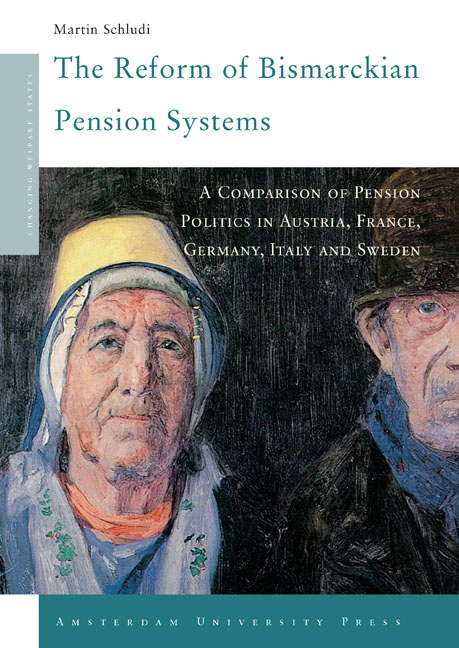 The Reform of Bismarckian Pension Systems
The Reform of Bismarckian Pension Systems Book contents
- Frontmatter
- Contents
- List of Tables/List of Figures
- Acknowledgements
- Introduction
- 1 The Need for Pension Reform:A Problem-Oriented Perspective
- 2 An Empirical Overview of Policy Change in Bismarckian Pension Regimes
- 3 The Politics of Pension Reform:An Actor-Centred Explanatory Framework
- 4 Sweden:Policy-Oriented Bargaining
- 5 Italy:Corporatist Concertation in the Shadow of EMU
- 6 Germany:From Consensus To Conflict
- 7 Austria:Reform Blockage by the Trade Unions
- 8 France:Adverse Prerequisites for a Pension Consensus
- 9 Conclusion
- Appendix I Summary Description of Retirement Systems (1986)
- Appendix II Chronology of National Pension Reforms
- Appendix III Glossary of Terms
- Notes
- Bibliography
- Index
Appendix III - Glossary of Terms
Published online by Cambridge University Press: 24 January 2021
- Frontmatter
- Contents
- List of Tables/List of Figures
- Acknowledgements
- Introduction
- 1 The Need for Pension Reform:A Problem-Oriented Perspective
- 2 An Empirical Overview of Policy Change in Bismarckian Pension Regimes
- 3 The Politics of Pension Reform:An Actor-Centred Explanatory Framework
- 4 Sweden:Policy-Oriented Bargaining
- 5 Italy:Corporatist Concertation in the Shadow of EMU
- 6 Germany:From Consensus To Conflict
- 7 Austria:Reform Blockage by the Trade Unions
- 8 France:Adverse Prerequisites for a Pension Consensus
- 9 Conclusion
- Appendix I Summary Description of Retirement Systems (1986)
- Appendix II Chronology of National Pension Reforms
- Appendix III Glossary of Terms
- Notes
- Bibliography
- Index
Summary
Accrual rate The percentage of assessed income that enters into the pension formula (usually 1% to 2%).
Actuarial neutrality Used here to indicate pension arrangements which neither penalise nor unduly benefit those who retire earlier or later than the standard retirement age.
Advance-funding In an advance-funded scheme, current contributions are set aside and invested in order to finance the pensions of current contributors. Many company plans are advance-funded as are individual retirement accounts. Public pay-as-you-go pensions may be partly pre-funded when the government raises the contribution rate above what is necessary to finance current benefits, in order to accumulate a fund to help pay future benefits.
Average effective retirement age The actual average retirement age, taking into account early re-tirement and special regimes.
Basic pension The single person's flat rate state pension paid to all who have met the minimum national insurance contribution requirement.
Beneficiary A person entitled to benefit under a pension scheme or who becomes entitled because of a specified event.
Benefit rate The ratio of the average pension to the average economy-wide wage or covered wage.
Beveridgian pension system Public pension arrangement based on meanstested or universal flat-rate benefits, either contribution- or tax-financed.
Bismarckian pension system Public pension arrangement based on earnings- related social insurance, typically financed out of wage-based contributions.
Consolidation A fiscal policy that aims to reduce public-sector deficits, or increase public-sector surpluses, by increasing taxes or reducing publicsector expenditures, or both.
Defined-benefit plan A pension plan where benefits are prescribed by a formula. It is the converse of a defined-contribution plan.
Defined-contribution plan A pension plan in which a periodic contribution is prescribed and the benefit depends on the contribution plus the investment return.
Demographic transition The historical process of changing demographic structure that takes place as fertility and mortality rates decline, resulting in an increasing ratio of older to younger people.
Equivalence principle Principle according to which monthly pension payments correspond to the individual contribution record.
Final pensionable earnings The pensionable earnings, at or near retirement or leaving service, on which the pension is calculated in a final salary scheme. The earnings may be based on the average over a number of consecutive years prior to retirement.
- Type
- Chapter
- Information
- The Reform of Bismarckian Pension SystemsA Comparison of Pension Politics in Austria, France, Germany, Italy and Sweden, pp. 269 - 272Publisher: Amsterdam University PressPrint publication year: 2005
